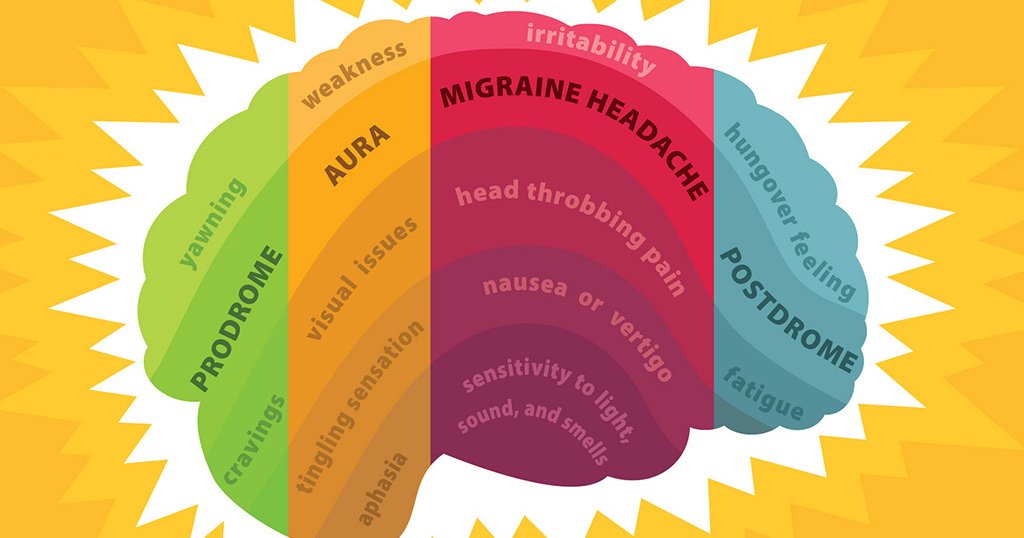Migraine is a complex neurological condition that can present with various symptoms, including headache, nausea, sensitivity to light and sound, and visual disturbances. Migraine stages are of four types: prodrome, aura, headache, and postdrome.
The prodrome stage can occur hours or days before a migraine attack and is characterized by mood, energy levels, and appetite changes.
The aura stage can include visual disturbances, such as seeing flashing lights or zigzag lines. Sensory aura such as numbness and tingling, and speech aura such as slurred speech and trouble speaking are the other most common types of aura.
The headache stage comes next and is often characterized by severe head pain, lasting from a few hours to several days. It often has a one-sided predominance, but can involve anywhere in the head on one or boths sides.
The postdrome stage can leave individuals feeling tired, irritable, or confused.
Understanding the different stages of a migraine attack can help individuals manage their symptoms more effectively and seek appropriate medical attention when necessary.
What are the 4 Stages of a Migraine Attack?
The migraine attack typically progresses through four stages: prodrome, aura, headache, and postdrome. Let’s discuss these more in depth.
The Prodrome stage
The prodrome stage is the first stage and can occur hours or even days before the onset of the headache. During this stage, individuals may experience various symptoms, such as fatigue, mood changes, food cravings, and increased urination.
Some people may also experience neck stiffness, constipation, or sensitivity to light and sound. Patients often say that they just have a feeling that is hard to describe, but they can feel something that usually alerts them that a migraine is coming in the next day or hours.
The Aura stage
The aura stage can follow the prodrome and last up to an hour. Approximately 25% of people with migraines experience aura. Aura can manifest as visual disturbances, such as seeing flashing lights, zigzag lines, blind spots, colors, jagged edges, shapes, or areas of lost vision. Visual aura is the most common.
Some patients get sensory aura such as numbness or tingling on one side of the body (typically face and arm most commonly), and around the mouth. Other people get dysphasia aura which manifest as speech disturbances such as slurred speech, trouble getting words out, or trouble understanding what is being said to them. Migraine aura should last between 5-60 minutes at a max per ICHD3 criteria.
The Headache stage
The headache stage is the most intense and recognizable stage of a migraine attack. The headache can be severe and is often accompanied by nausea, vomiting, sensitivity to light and sound, and other symptoms.
The pain is often described as a pounding, throbbing, or pulsating. The migraine stages can last for a few hours to several days, and it may be triggered or worsened by physical activity. It should last 4-72 hours untreated or unsuccessfully treated, although can last days or even weeks sometimes.
The Postdrome stage
The postdrome stage is the final stage of a migraine attack and can last for several hours to several days. During this stage, individuals may feel tired, irritable, or confused. Some people may also experience a sense of euphoria or feel exceptionally energized. Common complaints include brain fog, fatigue, head and body soreness, and all around just feeling terrible.
1. Prodrome
What is Prodrome?
Prodrome refers to the early stage or onset of a disease, particularly a psychological or neurological disorder, which occurs before the appearance of overt symptoms.
During the prodromal stage, an individual may experience subtle changes in their behavior, mood, cognition, or physical health that can precede the full onset of the disorder. These changes can be challenging to identify or diagnose since they are often nonspecific and can be attributed to other causes.
The prodromal period can vary depending on the disorder and individual, and it can last from days to years. Some disorders that can have a prodromal period include schizophrenia, bipolar disorder, major depressive disorder, Alzheimer’s disease, and Parkinson’s disease.
Common Symptoms of Prodrome
The symptoms of prodrome can vary depending on the disorder, but some common symptoms include:
- Mood changes: This can include feelings of anxiety, irritability, or depression that are out of character for the person. They may also experience mood swings or increased emotional sensitivity.
- Fatigue: Feeling tired or run-down despite getting adequate rest can be a prodrome symptom. The person may also have trouble sleeping or experience changes in their sleep patterns.
- Food cravings: The person may experience changes in their appetite or food preferences, such as craving sugary or high-carbohydrate foods. It can signify hormonal changes in the body or an increase in stress levels.
- Physical symptoms: Depending on the disorder, the person may experience physical symptoms such as headaches, muscle tension, or gastrointestinal disturbances. These symptoms can be difficult to attribute to a specific cause and may be nonspecific.
- Cognitive changes: The person may experience changes in their ability to concentrate, think clearly, or remember things. They may also need help with decision-making or problem-solving.
2. Aura
What is an Aura?
An aura is a perceptual disturbance that some people experience before migraines, headaches, or seizures. It typically lasts for several minutes to an hour and can include a variety of sensory, motor, speech, or cognitive symptoms.
Not all individuals with migraines or epilepsy experience an aura, and some may experience different types of prodromal symptoms before an attack or seizure. If you or someone you know experiences stages of migraine, an aura or other prodromal symptoms, it’s essential to seek medical attention to determine the underlying cause and appropriate treatment.
Common Symptoms of Aura
The symptoms of aura can vary depending on the individual and the underlying condition, but some common symptoms of aura include the following:
- Visual disturbances: This is one of the most common symptoms of aura and can include seeing flashing lights, zigzag lines, blind spots, or shimmering or wavy lines. Some people may also experience changes in color vision or temporary blindness in one eye.
- Sensory symptoms: Some people may experience tingling or numbness in the face, hands, or other body parts. It is often described as a feeling of pins and needles and can be accompanied by a sense of heaviness or weakness in the affected area.
- Motor symptoms: Some people may experience weakness or difficulty with coordination, such as stumbling or dropping objects. Others may experience difficulty with speech or language.
- Other symptoms: In addition to these common symptoms, some people may experience changes in mood or cognition, such as feeling anxious or confused.
3. Headache
What is a Headache?
A headache is typically one of the most prominent and debilitating symptoms in the context of a migraine attack. There are some stages of migraine. Migraines are a type of headache disorder that typically involves a throbbing or pulsing pain on one side of the head, although it can also occur on both sides. The headache associated with migraine can last anywhere from a few hours to several days and can be accompanied by various other symptoms.
Some common symptoms of a migraine attack in addition to headache can include:
- Sensitivity to light, sound, or smells
- Nausea or vomiting
- Blurred vision or other visual disturbances
- Dizziness or lightheadedness
- Fatigue or difficulty concentrating.
Common Symptoms of Headache
A headache is one of the most common and debilitating symptoms during a migraine attack.
Here are some of the common symptoms of headache during a migraine attack:
- Severe pain: The headache pain associated with a migraine attack is often described as a throbbing, pulsing, or pounding pain on one side of the head, although it can occur on both sides. The pain can be so severe that it can interfere with normal daily activities.
- Light sensitivity: Sensitivity to light, also known as photophobia, is a common symptom of migraine headaches. Even standard indoor lighting can be uncomfortable, and bright lights or sunlight can be unbearable.
- Sound sensitivity: Sensitivity to sound, also known as phonophobia, is another common symptom of migraine headaches. Even normal sounds, such as a car engine or conversation, can be overwhelming and painful.
- Nausea is another common symptom of a migraine attack. In more severe attacks, vomiting is also associated with the nausea.
4. Postdrome
What is Postdrome?
Postdrome is the final phase of the migraine stages, also known as the migraine hangover. It is a period that follows the headache phase and can last for several hours to several days. During this phase, the person may feel exhausted, irritable, or have difficulty concentrating.
Postdrome involves a range of physical and emotional symptoms, including:
- Fatigue: Feeling extremely tired and run down is one of the most common symptoms of postdrome. The person may need to sleep for an extended period to recover from the attack.
- Mood changes: The person may experience mood changes such as feeling irritable, depressed, or anxious. These mood changes can be related to the physical effects of the migraine attack on the brain.
- Difficulty concentrating: Some people may experience difficulty concentrating or feel mentally foggy during the postdrome phase. It can make it difficult to complete tasks or work. Brain fog is what patients often describe this as.
- Headache or neck pain: Some people may experience a mild headache or neck pain during the postdrome phase.
- Gastrointestinal symptoms: Some people may experience gastrointestinal symptoms such as nausea, vomiting, or diarrhea.
Common Symptoms of Postdrome
Postdrome, also known as the “migraine hangover,” is the final phase of a migraine attack. During this phase, the person may experience a range of physical and emotional symptoms, including:
- Fatigue: Feeling extremely tired and run down is one of the most common symptoms of postdrome and other stages of migraine. The person may need to sleep for an extended period to recover from the attack.
- Mood changes: The person may experience mood changes such as feeling irritable, depressed, or anxious. These mood changes can be related to the physical effects of the migraine attack on the brain.
- Difficulty concentrating: Some people may experience difficulty concentrating or feel mentally foggy during the postdrome phase. It can make it challenging to complete tasks or work.
- Headache or neck pain: Some people may experience a mild headache or neck pain during the postdrome phase.
- Gastrointestinal symptoms: Some people may experience gastrointestinal symptoms such as nausea, vomiting, or diarrhea.
Conclusion
Understanding migraine stages – prodrome, aura, headache, and postdrome – can help individuals with migraines better manage their symptoms and seek appropriate treatment. By recognizing the warning signs of a migraine attack and addressing symptoms as they arise, people can work to minimize the impact of migraines on their daily lives.
IF YOU HAVE HEADACHE, MIGRAINE, OR FACIAL PAIN AND ARE LOOKING FOR ANSWERS ON ANYTHING RELATED TO IT, A HEADACHE SPECIALIST IS HERE TO HELP, FOR FREE!
FIRST, LET’S DECIDE WHERE TO START:
IF YOU HAVE AN EXISTING HEADACHE, MIGRAINE, OR FACIAL PAIN DIAGNOSIS AND ARE LOOKING FOR THE LATEST INFORMATION, HOT TOPICS, AND TREATMENT TIPS, VISIT OUR FREE BLOG OF HOT TOPICS AND HEADACHE TIPS HERE. THIS IS WHERE I WRITE AND CONDENSE A BROAD VARIETY OF COMMON AND COMPLEX MIGRAINE AND HEADACHE RELATED TOPICS INTO THE IMPORTANT FACTS AND HIGHLIGHTS YOU NEED TO KNOW, ALONG WITH PROVIDING FIRST HAND CLINICAL EXPERIENCE FROM THE PERSPECTIVE OF A HEADACHE SPECIALIST.
IF YOU DON’T HAVE AN EXISTING HEADACHE, MIGRAINE, OR FACIAL PAIN DIAGNOSIS AND ARE LOOKING FOR POSSIBLE TYPES OF HEADACHES OR FACIAL PAINS BASED ON YOUR SYMPTOMS, USE THE FREE HEADACHE AND FACIAL PAIN SYMPTOM CHECKER TOOL DEVELOPED BY A HEADACHE SPECIALIST NEUROLOGIST HERE!
IF YOU HAVE AN EXISTING HEADACHE, MIGRAINE, OR FACIAL PAIN DIAGNOSIS AND ARE LOOKING FOR FURTHER EDUCATION AND SELF-RESEARCH ON YOUR DIAGNOSIS, VISIT OUR FREE EDUCATION CENTER HERE.



